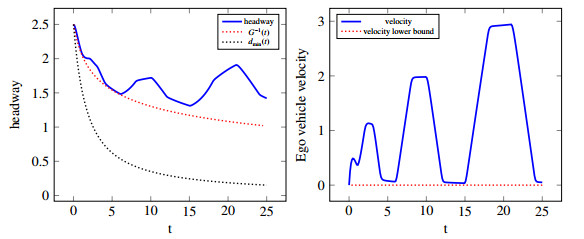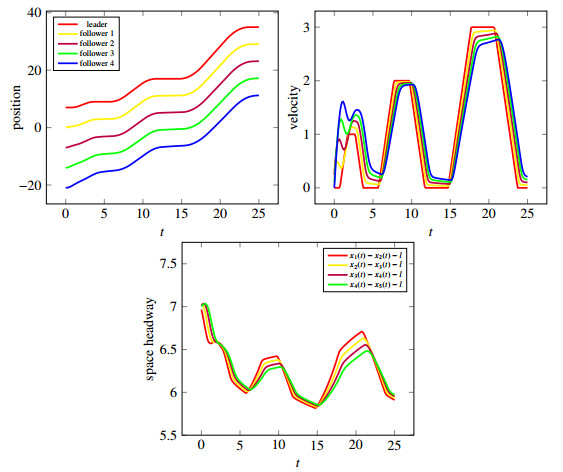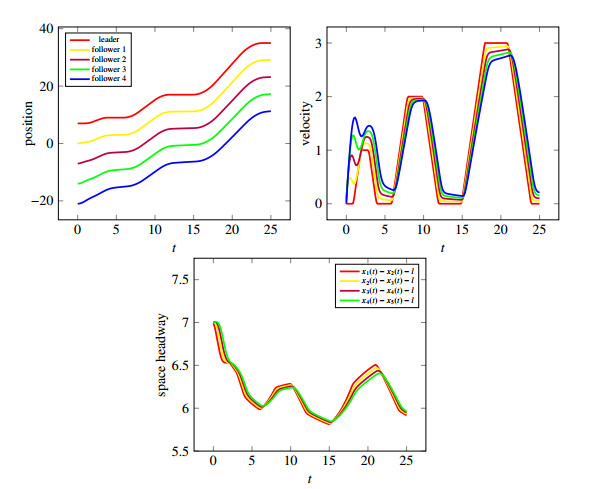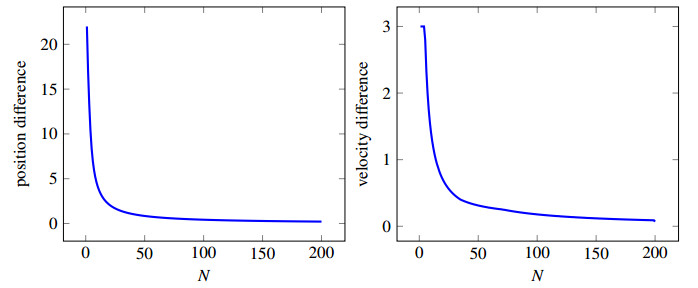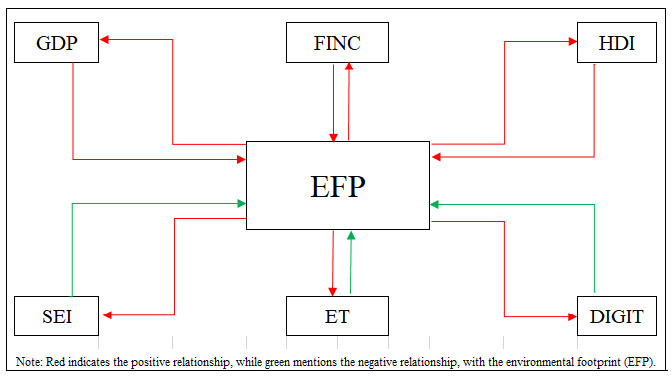1.
Introduction
In approximating traffic flow dynamics by dynamical systems, we observe phenomena like "stop and go" waves [34] and "phantom shocks" [33,16]. It is likely that these phenomena are partially caused by a reaction delay of the participating drivers. In most of the existing car-following models, no delay had been introduced, on the contrary the delay was often interpreted model intrinsically. However, dynamical systems allow in a very straight forward way to introduce a time-delay. This is what we will cover in this contribution. Using the well-known Bando-follow the leader (Bando-FtL) car following model [34] we assume that velocity and position of the leading car is only taken into account in a delayed way for determining the ego vehicle' (i.e., the follower's) acceleration and study the well-posedness of the underlying model (compare in particular Definition 4.1). This is a first step in analyzing rigorously delay in car following models although the delay in this contribution is not realized as typically done in delay ordinary differential equations (the solutions itself are subject to delay) but only the leading vehicle's velocity and position is incorporated in the acceleration function of the ego vehicle in a delayed sense.
Another point which is addressed in this contribution is the question of existence of solutions and lower and upper bounds on specific derivatives. As it has been noticed in [1], a careful study of existence of solutions of car-following models has to the authors' knowledge not been undertaken and leaves most car following models, particularly the second order nonlinear models-which are intensively used in applied sciences-in a position that there is just "the hope" that they will behave properly also for "non-standard" initial data. This is why we prove the existence and uniqueness of solutions to the Bando-FtL second order car-following model and provide explicit bounds under the assumption that the leading vehicle does not drive backwards. These bounds will come in handy for different tasks, among these studying related optimal control problems and existence of minimizers. The well-posedness, i.e., existence and uniqueness of solutions, becomes also more and more important as numerical traffic simulators use specific classes of car following models with rather complex lane changing dynamics necessitating a careful study on the well-posedness which can also shed light on the required discretization in the numerical approximation and more.
We also prove that when delay of the delayed car following model converges to zero, the solutions converge to the solutions of the undelayed model, somewhat underlining the intuition that the considered car following model is robust (in the uniform topology) with regard to delay and that-therefore-the currently used non-delayed versions might be an acceptable approximation of the "closer" to reality delayed car-following models.
1.1. Literature
The literature on car following models is vast and we will only give a short overview, mentioning that this overview cannot be complete.
First attempts in car following modeling can be found in [11,15]. Among all the car-following models existing in the literature (see for instance [3,6,8,30,31]) it is worth naming the Optimal Velocity Model [4], the Bando-follow-the-leader (Bando-FtL) model [34] which is the model we analyze in this contribution, and the Intelligent Driver Model (IDM) (with modifications and extensions) [35,25,14,32,26,27]. For a comprehensive overview of the main car-following models we refer to [36,28,19].
For car-following models with delay, a lot of contributions can be found as well. We name [38] which proposes an ODE (ordinary differential equation) model with two delays, one in the velocity of the considered vehicle (potentially time dependent) and one in the headway difference and thus delaying also the dependency of the acceleration on its own position. Yu et al. consider in [37] again a second order car following model with delay in both relative position and relative velocity so that once more the delay is not just in the position and velocity of the leading vehicle. Bando et al. study in [5] delayed car-following models where the delay is located in position and velocity and the leading vehicle's velocity is not taken into account (first and second order). In [12], a second order car following model based on the optimal velocity (which is also part of the Bando-FtL model we use in this work Definition 2.1) with delay in the headway is investigated. Zhu et al. model car following in [39] with a first order model and delay in the headway. Keane et al. calibrate with recorded data in [22] in a general car-following model with different delays using adjoint methods to optimize the incorporated parameters. Jiang et al. investigate in [20] the famous Nagel Schreckenberg cellular automaton (see also) [29] with delay, again both velocities (leading and ego vehicle) are delayed. None of the previous contributions perform a mathematical analysis of the well-posedness (i.e., existence and uniqueness of solutions) and clearly, for specific versions of delay the solution can break down in finite time if one for instance has a denominator in the model which incorporates headway. Also, none of the named contributions considers a delay only in the information about the leading vehicle' position and velocity which we deal with in this contribution (see particularly Definition 4.1). For macroscopic modelling with explicit time delay, we refer the reader to [23] where nonlocal conservation laws are used to model traffic and where the authors prove existence and uniqueness of solutions, and to [10] which considers similarly macroscopic conservation laws to model traffic but this time locally in space, running, due to delay, into the problem of infeasible solutions for specific initial datum.
In [24,17], the foundations for using car-following models in mean-field modelling are laid necessitating the study of well-posedness of the used car-following models.
1.2. Outline
Section 2 defines the involved functions and parameters for the "Bando-FtL" car following model and Subsection 3 then presents the considered system of initial value problems together with the result on the well-posedness under rather weak conditions on the involved functions in Theorem 3.3. The key idea is that the car-following model can partially be integrated so that lower bounds can be obtained. Section 4 then introduces the delayed car-following model which is detailed in Definition 4.1. Thanks to the structure of the delay, the well-posedness can be proven analogously as in the undelayed case and one obtains almost identical lower and upper bounds on the involved derivatives. In Subsection 5 we then study the convergence of solutions when the delay approaches zero and can indeed prove in Theorem 5.2 the convergence in W1,∞, to the non-delayed solution and thus in the uniform topology not just for the position but also the velocity. The main argument is based on some compactness results together with the bounds on the solution, derived before. Section 6 generalizes the existence and convergence results described before to the many car case, the typical situation in applications. In Subsection 7, some numerical simulations are presented to illustrated the obtained results and in particular the effect of the delay, increasing the variation on velocity (phantom shocks, etc.) significantly. We conclude in Subsection 8 with some challenging open problems, particularly considering corresponding optimal control problems and more general versions of delay.
2.
Problem definition
In this section, we first introduce the considered car following model, the Bando-FtL model, which had been introduced in [34]. We start with defining the "Bando-FtL" acceleration.
Definition 2.1 (Bando-FtL acceleration). Let l∈R>0 be the car length,
(α,β)∈R2>0 and
we call the following function Acc the Bando-FtL acceleration
Remark 1 (The definition of Acc). If we take (x,v),(xℓ,vℓ)∈R×R≥0 as the ego vehicle' and the leading vehicle' position-velocity vectors, the definition of Acc in Definition 2.1 indicates that the acceleration is dependent on leading vehicle's velocity and position as well as ego vehicle's velocity and position. However, in the considered setup, the situation is slightly more easy, as the acceleration term only depends on the ego vehicle's space headway xℓ−x−l and not explicitly on the positions xℓ and x. To keep consistent and to be able to incorporate later dynamics for the ego vehicle where the position and velocity of the leader are delayed, the current notation seems reasonable (see Definition 4.1 and in particular Eq (4.4)).
The "follow the leader" term in the definition of Acc in Definition 2.1, i.e.,
guarantees that the ego vehicle would accelerate if its velocity is smaller than the leading vehicle's velocity, i.e., v<vℓ and decelerate if v>vℓ. In the extreme case when both the ego vehicle and its leading vehicle drive at the same velocity and small headway, the Bando term in the definition of Acc in Definition 2.1, i.e.
makes the ego vehicle decelerate to increase its space headway due to the monotonicity of the optimal velocity function V in Eq (2.1). On the other hand, if the headway would be very large, V(xℓ−x−l) would be almost maximal (thanks to the properties on V in Eq (2.1)) so that the headway would decrease (compare in particular Remark 2 and Eq (2.3)).
Remark 2 (An example for the optimal velocity function V). Let vmax∈R>0 be the maximal velocity and ds∈R>0 a given parameter. One example of an optimal velocity function, see Figure 1, consists of
where l∈R>0 is the car length. In particular, if the ego vehicle's space headway xℓ−x−l is large enough, the Bando term in the definition of Acc in Definition 2.1 forces the ego vehicle's velocity toward the maximal velocity vmax∈R>0.
3.
Well-posedness: Real-time information available–the undelayed case
In the following, we give the precise definition of the car-following model we will study. In the most simplistic case it is enough to have only two vehicles, the leading vehicle which has its velocity and position given, and the ego vehicle which will be subject to the car-following dynamics as follows:
Definition 3.1 (The Bando-FtL – the undelayed case). For T,vℓmax,l∈R>0, and Acc as in Definition Definition 2.1 we consider the following initial value problem in (xℓ,x)∈W2,∞((0,T))2
with the leading vehicle acceleration satisfying
and the initial values (x0,xℓ0)∈R2 so that
Remark 3 (The leading vehicle trajectory). As can be seen from the previous Definition 3.1, the leading vehicle's position xℓ is uniquely determined by ulead and its initial position and velocity xℓ0,vℓ0. The condition in Eq (3.7) assures that the leading vehicle's velocity is never negative and bounded from above by vℓmax, a reasonable assumption for microscopic vehicle dynamics. Thus, generally, we can assume that xℓ is just a given trajectory. However, as we are later on also interested in optimal control related questions, we describe the leading vehicle's trajectory in terms of acceleration and not in terms of position/velocity.
In the definition of Ulead it might make sense to add additional lower and upper bounds, for instance replacing Ulead by ˜Ulead with
with the lower bound umin∈R<0 and upper bound umax∈R>0 on the acceleration. From an application point of view, such bounds are quite natural as maximal deceleration and acceleration in ordinary traffic situations are estimated to be around −2ms2 and 4ms2 (m denoting meters and s seconds), see [7,2,21]. However, for our analysis we only require the velocity of the leading vehicle to not become negative, and left these additional and in application for sure reasonable assumptions aside.
As described in Remark 3 in our analysis we only need to focus on Eqs (3.3)–(3.5) and can just assume that leader's position and velocity is given. We consider as solutions classical solutions in the extended case which we will state as follows:
Definition 3.2 (Extended classical solution-Non-delayed). Given (T,vℓmax,l)∈R3>0, Acc as in Definition Definition 2.1 and the initial values (x0,xℓ0,v0,vℓ0)∈R2×R2≥0 so that
the mapping
is called the classical solution of the Eqs (3.1)–(3.6) in the extended case if it satisfies the following integral equation
Now we study the well-posedness, that is the existence and uniqueness of the solution of the Eqs (3.1)–(3.6) in the extended case.
Theorem 3.3 (Well-posedness, minimal distance for the Bando-FtL model). Consider the Bando-FtL model in Definition 3.1 with the assumptions therein. Then, there exists a unique solution x∈W2,∞((0,T)) in the sense of Definition 3.2 on any finite time horizon T∈R>0, the solution satisfies with the constants
the minimal distance ∀t∈[0,T]
has nonnegative bounded velocity (from above and from below) ∀t∈[0,T]
and upper and lower bounded acceleration ∀t∈[0,T]
Proof. As the initial datum is assumed to satisfy xℓ0−x0−l>0 and as V∈C1(R≥0;R≥0)∩L∞(R≥0) there exists a small time horizon T∗∈R>0 so that on t∈[0,T∗] the right hand side of the second order ODE in Eqs (3.3) and (3.4) is Lipschitz-continuous so that we have by the Picard-Lindelöf theorem [18, Chapter II,Theorem 1.1] a unique solution (for the initial value problem in xℓ there is nothing to do, it does not depend on anything except an a priori given function ulead). Let us next consider-on this time horizon [0,T∗]∋t – the difference in the change of velocities and estimate:
Integrating over [0,t] and recalling that ˙xℓ−˙x≡vℓ−v we end up with
Substituting h(t)xℓ(t)−x(t)−l, we then have
with A as in Eq (3.8). As can be seen, for h(t) small, the right hand side becomes strictly positive so that the distance cannot decrease anymore. And indeed, we have
However, from this we can conclude as lower bound for h
as long as the initial datum h(0)=xℓ0−x0−l also satisfies this lower bound. If it does not, the initial datum itself becomes the lower bound as by Eq (3.15) h is then increasing. Concluding, we have
As we will show in the following, it holds that
so that the lower bound can be simplified. In fact, estimating as follows and squaring the discriminant we have for t∈[0,T]
This is exactly the term which we need to estimate against to obtain that
from which it follows that
what we wanted to show. Furthermore, for all t∈[0,T], we have
● that Eq (3.11) holds as long as the solution exists,
● the existence and uniqueness of the solution on the considered time horizon [0,T] as we can lower bound the distance with the estimate from above.
To show that the velocity of the ego vehicle, ˙x≡v satisfies the claimed bound we estimate as follows-taking advantage of the fact that by Eq (3.7) we have vℓ(t)≥0 ∀t∈[0,T] and by Eq (2.1) V≧0
and integrating over [0,t] gives
which is the lower bound in Eq (3.12). As both latter terms, v0 and t↦exp(−∫t0αdmin(s)2+βdmin(s)2ds), are nonnegative, the velocity is bounded from below by zero. For the upper bound, we estimate (using that v≧0 as established previously)
If v(t)>‖V‖L∞(R)+βαvℓ(t)d2min(t), we have ˙v(t)<0 so that we indeed obtain as upper bound
Finally, let us prove the acceleration bounds. Recall the acceleration formula in Definition 2.1, Eq (2.2) once more
and the upper and lower bound of the velocity in Eq (3.12), we estimate for the upper bound on the acceleration
which is exactly Eq (3.13). For the lower bound, estimate as in Eq (3.17) for t∈[0,T]
This concludes the proof.
Remark 4 (Some comments on the Bando-FtL model). The results in Theorem 3.3 need to be interpreted in terms of their applicability and reasonability. It is worth mentioning that none of the previously obtained bounds depend on the behavior of the leading vehicle, except that it never drives backwards, i.e., its velocity is non-negative, and make the estimates to some extend not very sharp. On the other hand, they are strong as they do not require any additional assumptions which comes in particular handy when applying the results to some optimal control problems where uniform bounds are required but the leading vehicle's trajectory cannot be specified a priori except from knowing that the leading vehicle's velocity does not become negative.
3.1. Strictly positive velocity
The inequality in Eq (3.12) guarantees that the velocity never becomes negative (independent on what the leading vehicle trajectory does) and not even zero as long as the initial velocity v0 was not zero. From an application point of view, one might criticize a behavior stating that the velocity never becomes zero. On the other hand, the velocity can become very small so that the modelling can still be justified. The upper bound on the velocity is clearly not sharp, as it relies on dmin which is the "worst case" estimate for the lower bound on the distance. Additionally, we have not postulated anything additional on V so that also V is estimated in a "worst case" way.
3.2. The lower bound and the impact of A,B
Looking at dmin as in Eq (3.9) one can observe that dmin>0 as 4αβ>0 and α>0. The constant A could either be positive or negative, however for large time horizon T∈R>0 or small initial space headway xℓ0−x0−l, the constant A will be negative. Thus the minimal distance dmin approaches 0 as the time horizon T gets large or the initial space headway xℓ0−x0−l approaches 0.
3.3. The bounds on the acceleration
The derived bounds on the acceleration in Eq (3.13) are once more "worst case" estimates and are clearly not sharp. However, for theoretical studies they enable uniform bounds independent on what the leading vehicle does as long as it does not drive backwards, and prove to be of significant help.
The previous Theorem 3.3 has shown among other things how to obtain a lower bound on the distance and can be refined further. In the following remark, we detail this:
Remark 5 (Minimal distance of the Bando-FtL model revisited). In Theorem 3.3 we estimated the ego vehicle's optimal velocity on the time t∈[0,T], T∈R>0, V(xℓ(t)−x(t)−l), (see in particular Eq (3.14)) from above by ‖V‖L∞(R≥0). One can also keep the ego vehicle's optimal velocity and obtain for t∈[0,T]
with
As can be seen, for h(t) small, the right hand side of the above inequality becomes strictly positive as long as the integral term does not increase too much so that the space headway h cannot decrease anymore. Indeed, define for t∈[0,T], F[h](t)A1−α∫t0V(h(s))ds−αh(t)+β1h(t). Then we are interested in the zeros for this operator as it will tell us when the headway increases/decreases. Thus, we study
and as this needs to hold for all t∈[0,T], we can take the derivative with respect to t on both sides and obtain
Let
Then, G is strictly monotonically decreasing with respect to a and thus invertible, which is why we can write
We claim that h∗(t)>0 ∀t∈[0,T]. To this end, recall Eq (3.19) and estimate as follows assuming that h∗(t)≤h(0)
and solving the least inequality for h∗(t) we obtain
and thus ∀t∈[0,T]
which is indeed comparable with the lower bound in Eq (3.9).
However, similarly to the reasoning in Theorem 3.3, we can conclude as lower bound for h then
which is generally a sharper bound. The only problem with this bound is that one needs to find the function G−1 which is only implicitly defined by Eq (3.20). As it only contains the computation of an integral, this is at least numerically feasible. Clearly, based on this estimate, the bounds on the derivatives of x, i.e., velocity and acceleration (compare Eqs (3.12) and (3.13) can be improved as well, however, we will not detail this.
Example 1 (Lower bounds). Now we assume that the leading vehicle's acceleration ulead at time t∈[0,∞) satisfies the following
which is illustrated in Figure 2 and the following vehicles' acceleration is determined by the Bando-FtL model as defined in Definition 2.1. Then, we obtain the following on the time horizon T=25 assuming that the ego vehicle's acceleration has the constants as in Eq (7.1). Assume that the initial datum for the leading and following vehicle satisfy (xℓ0,x0)=(l+ds,0)=(4.5+2.5,0) and (vℓ0,v0)=(0,0). In addition, we choose the parameters α=0.5,β=20,vmax=10,l=4.5,ds=2.5 (these are according to [21] reasonable choices). According to Theorem 3.3, we have
By Remark 5 and numerical integration, we obtain another lower bound G−1(t) which is illustrated in Figure 3 together with dmin(t). As can be seen, the lower bound G−1(t) on the headway is rather sharp particularly for smaller time horizon, however, the lower bound of the velocity is very conservative as it is zero. We have not even computed the upper bound as it is very large.
As we will later on use this specific acceleration file again, we comment on its properties:
Remark 6 (The leading vehicle's acceleration). The leading vehicle's acceleration ulead as defined in Eq (3.22) is changing among 0,1,and−1 in a non-periodical way. That is, the first leading vehicle repeats the pattern "constant velocity, accelerate, constant velocity, decelerate" non-periodically, see Figure 2.
4.
Well-posedness: No real-time information available–the delayed case
In this section, we introduce–based on the original Bando-FtL–a delay in the reaction to the leading vehicle's position and velocity which can be interpreted as the information delay the ego vehicle is exposed to either due to their own reaction time or more realistically due to the time required to evaluate the obtained information on the leader in a suitable way. We want to underline that from a mathematical point of view, this is not a typical delay ordinary differential equation as these types of equations usually involve a delay in the solution of the modelling equation itself [13] and not some externally given dependencies (as the leading vehicle's trajectory). The model reads mathematically as follows:
Definition 4.1 (The Bando-FtL – information delay with respect to the leading vehicle). For T,vℓmax,l∈R>0 and Acc as in Definition Definition 2.1 we consider for a delay δ∈R>0 the following initial value problem in (xℓ,x)∈W2,∞((−δ,T))×W2,∞((0,T))
with the leading vehicle acceleration satisfying
and the initial values (x0,xℓ,−δ)∈R2 so that
as well as (v0,vℓ,−δ)∈R2≥0.
Remark 7 (Information delay – a more conservative approach). Interestingly, taking a delayed version of the leading vehicle trajectory into account for the ego vehicle's acceleration will lead to a more conservative approach as one will assume that the car is actually closer (as xℓ(t−δ)≤xℓ(t) ∀t∈[0,T]). However, this will mean that the ego vehicle will break sooner than in the non-delayed case and potentially increase the variation in velocity. We will dwell on this question in particular in Subsection 6.
Remark 8 (The definition of Uleadδ). As can be seen from the previous Definition 4.1, analogously to the undelayed case in Subsection 3 the leading vehicle's trajectory xℓ is uniquely determined by ulead and the leading vehicle's position and velocity at time −δ, (xℓ,−δ,vℓ,−δ). The condition in Eq (4.7) assures that the leading vehicle's velocity is never negative and is bounded from above by vℓmax, a reasonable assumption for microscopic vehicle dynamics.
We again consider the extended classical solutions for the delayed case as follows:
Definition 4.2 (Extended classical solution – delayed case). Assume T,vℓmax,l∈R>0, δ∈R≥0, Acc as in Definition Definition 2.1. Let the initial values (x0,xℓ−δ)∈R2 be given so that
we call (xℓ,x,v)∈W2,∞((−δ,T))×W2,∞((0,T))×W1,∞((0,T)) the classical solution of Eqs (4.1)–(4.6) in the extended cases if the following integral equations are satisfied
The following theorem is almost identical to the non-delayed case in Theorem 3.3, the only difference being in that we use delayed information of leading vehicle position and velocity. However, as both are delayed by the same amount of time δ∈R>0, the model behaves identical when replacing the leading vehicle trajectory in Theorem 3.3, ulead by a new ˜ulead which is delayed, i.e., setting
Theorem 4.3 (Well-posedness for the information delayed Bando-FtL model). Given the initial value problem in Definition 4.1 with the therein stated assumptions, in particular that (xℓ−δ,vℓ−δ)∈R×R≥0 and ulead∈Uleadδ are chosen so that
there exists for each T∈R>0 a unique solution of the initial value problem in Definition 4.1 on the time horizon [0,T] in the sense of Definition 4.2 and the solution satisfies the lower bound
with
and (α,β,l)∈R3>0 as in Definition 2.1.
Additionally, for all t∈[0,T] we have for the velocity ˙x and its derivative, the acceleration, the following lower and upper bounds ∀t∈[0,T]
Proof. Since both the velocity and position of the leading vehicle delay by the same amount of time δ, the proof of this theorem is similar to the proof of Theorem 3.3. Therefore, we omit the proof here.
Remark 9 (Generalizations of Theorem 4.3). We want to stress that the same steps as in Subsection 3 to improve the lower bound on the minimal distance Remark Remark 5 can also be taken in the delayed case.
5.
Convergence of solutions when delay tends to zero
The considered class of car-following models should be continuous with regard to delay as otherwise, they would prove to be not very realistic as the driver behavior is clearly subject to information delay. This is why in our following analysis we will prove that the delayed solution of Definition 4.1 converges to the un-delayed solution of Definition 3.1 in the proper topology. To this end, we require the following theorem which states a well-known result about Banach spaces and ((sub)-sub)-sequences.
Lemma 5.1 (Convergence of (sub)-subsequences to the same limit implies convergence of the sequence). Let B be a real Banach space and {xn}n∈N≥1⊂B be a sequence. Assume that there exists x∗∈B so that for each subsequence {xnk}k∈N≥1 there exists a (sub)-subsequence {xnkl}l∈N≥1 converging to x∗, i.e.,
Then, the original sequence {xn}n∈N≥1 converges to x∗, \ i.e.,
Proof. We prove by contradiction and assume that the original sequence {xn}n≥1 does not converge to x∗∈B. Then there exists ε0>0, such that for every M∈N≥1, there exists mM∈N≥1 with mM>M, such that
For the thus constructed subsequence {xmM}M∈N≥1, there is no (sub)-subsequence converging to x∗∈B which is a contradiction to the fact that {xn}n∈N≥1 does not converge. As it converges, and as the limit of each converging subsequence is x∗, the original sequence must also converge to x∗.
Equipped with this convergence result, we state the main theorem of this section, the convergence of delayed solution to the non-delayed solution if delay converges to zero, in the W1,∞ topology.
Theorem 5.2 (Convergence delayed solution to non-delayed for delay to zero). Given δ∈R>0 and denote by x[δ]∈W2,∞((0,T)) the unique solution to Definition 4.1. Let x denote the solution of the non-delayed Bando-FtL model in Definition 3.1. Then, the delayed solution converges to the non-delayed solution in the following sense:
Proof. Take t∈[0,T] and recall the uniform bounds (with regard to (δ)) on the acceleration as stated in Eqs (4.10) and (4.11) for a fixed finite time T∈R>0.
Then, we have that
Using Ascoli-Arzela's theorem [9, Theorem 4.25] we have
Recalling the definition of extended classical solutions for x[δk] it states that
Thanks to the compactness result above in particular that x[δk] and ˙x[δk] converge in the uniform topology for k→∞, by Acc being Lipschitz (guaranteed by the lower bound on the distance as stated in Eq (3.11) in Theorem 4.3) and as xℓ,vℓ∈C([−δ,T]), we can pass to the limit and indeed recover the non-delayed definition of the Caratheodory solution to Definition 3.1, i.e., for every t∈[0,T],
As this can be done for every sequence (δkn)n∈N≥1 and as we know that there exists a unique solution to the non-delayed initial value problem in Eq (5.1) as guaranteed by Theorem 3.3 we can finally invoke Lemma 5.1 and obtain the claimed convergence of the entire sequence to the non-delayed solution. This concludes the proof.
Remark 10 (Convergence of the related accelerations). The convergence in Theorem 5.2 can be extended directly to the acceleration ¨x[δk] as well, as the acceleration is according to Eq (4.4) fully determined by
and as the right hand side converges uniformly for δk→0, the left hand side does as well.
6.
Extensions to the multi vehicle case
In this section, we will generalize our results to cover many cars. However, as there is an order of dependency, i.e., the dynamics of the current vehicle only depend on its leading vehicle, the extension is quite straight forward. Let us first define what we mean with the many-vehicle case for the original Bando-FtL model:
Definition 6.1 (The car-following model for many vehicles). Let T>0 and N∈N≥1 be given. We assume that the parameters of the Acc satisfy what we have assumed in Definition Definition 2.1 as well as the leading vehicle acceleration ulead. Additionally, we assume for the initial datum (position and velocity)
Then, the dynamics for the Bando-FtL model with many vehicles N\in \mathbb N_{\geq1} read in (\boldsymbol{x}, \boldsymbol{v}):[0, T]\rightarrow \mathbb R^{N}\times \mathbb R^{N} \; \forall t\in[0, T] as
The system for many cars is illustrated in Figure 4.
Remark 11 (The model parameters for the many car case). One may choose different parameters (\alpha_i, \beta_i) \in \mathbb R_{>0}^2 in the Bando-FtL model defined in Definition 2.1 for different following vehicles i \in \{2, \dots, N\}. For convenience, in Definition 6.1, we have set (\alpha_i, \beta_i) = (\alpha, \beta) \in \mathbb R_{>0}^2 for each i \in \{2, \dots, N\}.
The following theorem gives the well-posedness of the above delayed Bando-FtL model for many vehicles, i.e., the minimum space headway of each following vehicle i \in \{2, \dots, N\} and the uniform bounds on the following vehicles' accelerations and velocities.
Theorem 6.2 (Minimum space headway and bounds on acceleration and velocity). Given the initial value problem in Definition 6.1 with the therein stated assumptions, there exists for each T\in \mathbb R_{>0} a unique solution in the sense of Definition 3.2 of the initial value problem on the time horizon [0, T] and the solution satisfies the lower bound
for i\in\{2, \ldots, N\} with
and (\alpha, \beta, l)\in \mathbb R_{>0}^{3} as in Definition 2.1. Additionally, for all t \in [0, T] we have for the velocity \dot{ \boldsymbol{x}} and its derivative, the acceleration, the following lower and upper bounds \forall (t, i)\in[0, T]\times\{2, \ldots, N\}
and upper and lower bounded acceleration \forall t\in[0, T]
Proof. The proof is a straightforward adaption of Theorem 4.3 as the number of vehicles is finite and the system is one-sided coupled (the ego vehicle acceleration is a function of the leading vehicle position and velocity only. So we omit the proof here.
Remark 12 (Dependency of the bounds in Theorem 6.2). The bounds on \dot{ \boldsymbol{x}}_{i} as well as on \ddot{ \boldsymbol{x}}_{i} for i\in\{2, \ldots, N\} depend on the velocity \dot{ \boldsymbol{x}}_{i} of the corresponding leading vehicle. However, as the system is coupled in the way that the dynamics of the ego vehicle only depend on the leading vehicle velocity, these bounds are explicit (although not very sharp). Choosing i = 1 we can indeed rely on the leading vehicle velocity
Then, continuing forward in i\in\{2, \ldots, N\} the velocities of the previous vehicle are know or can at least be bounded by the previously stated estimates a priori.
Remark 13 (Extension to the delay case and convergence for delay to zero). Following the same reasoning as in Subsection 4 the many car case dynamics in Definition 6.1 can be extended to the many car case with delay where each car can have a different delay for incorporating the information on the leading vehicle trajectory position and velocity into the acceleration function. It can also be shown that the solution of the delayed system of (one-sided) coupled car-following models converges to the undelayed solution when the delay of all car-following models converges simoultaneously to zero. Again, the idea is to apply inductively Theorem 5.2. We do not go into details.
7.
Numerical simulation
In this section, we assume that the first leading vehicle's acceleration a at time t \in [0, \infty) satisfies again the profile which has been defined in Eq (3.22) and illustrated in Figure 2. It somewhat mimics a traffic situation where the leading vehicle brakes, speeds up and remains at a constant velocity at different times and thus deals with the "extreme" cases in traffic. We consider both the non-delayed and delayed Bando-FtL model with five vehicles. For all solutions we use as parameters
with the optimal velocity function as in Eq (2.3).
The non-delayed solution which is obtained by a Runge-Kutta method of order 4 (ode45 with matlab) is illustrated in Figure 5. The left illustration demonstrates the vehicles' position, the middle the vehicles' velocity and the right one the headway. As we have chosen for the leading vehicle trajectory the acceleration in Figure 2 this type of stop and go behavior passes over to the following cars in a slightly smoothed fashion with the most "smooth" velocity that of the last vehicle, which is depicted as follower 4. In Figure 6 we introduce the mentioned delay with the delay between leading vehicle and follower 1 of \delta_{2} = 5 , the delay between follower 1 and follower 2 of \delta_{3} = 4 , the delay between follower 2 and follower 3 \delta_{4} = 3 and finally, the delay between follower 3 and follower 4 \delta_{5} = 2 . The delay affects the velocities which are in their reaction delayed (and are further delayed with regard to the corresponding leading vehicle the larger the delay) which results in an increased headway variation and additional variation in speeds which one can interpret as an increased potential for phantom shock. In Figures 7–9 the delays are decreased more and more and indeed the headway variation reduces so that when comparing the results with the smallest delay, i.e., Figure 9, the difference to the undelayed result in Figure 5 is relatively small underlining the proved convergence in Subsection 5 and Theorem 5.2.
This convergence is also illustrated in Figure 10 where in the left picture the L^{\infty} distance of the delayed position and the non-delayed position is illustrated and in the right picture the corresponding velocity difference again in L^{\infty} . We choose the vector of delays \boldsymbol{{\delta}}_N = \tfrac{1}{N}(\delta_2, \delta_3, \delta_4, \delta_5) , N \in \mathbb{N}_{\geq 1} . Note that the delay \delta_i , i\in \{2, 3, 4, 5\} , approaches zero as N \to \infty . The convergence of the position is faster (which is easily explained as the position is the anti-derivative of the velocity).
8.
Conclusions and future research
We have studied the well-posedness of a specific car following model and have provided lower and upper bounds on velocity and acceleration which come in handy when considering particularly optimal control problems. We have introduced a delay which instantiates that the ego vehicle might react on the leading vehicle position and velocity only in a delayed sense.
Future research should address:
● different types of delays, particularly in the leading vehicle trajectory.
● the stability of traffic equilibria when introducing delays.
● the long-time behavior assuming that the leading vehicle drives with constant velocity.
● model validation, i.e., testing whether integrating a delay (and which value) into the model is more precise. Clearly, many traffic phenomena could be seen as artefacts caused by delay.
● introducing delay in other car-following models as well and understanding whether there is a substantial difference (for instance, in the intelligent driver model (IDM) [35] we cannot expect similar results as the "follow the leader part" cannot be directly integrated and the model generally has additional flaws [1]).
Acknowledgements
We would like to express our gratitude to the anonymous reviewers who helped to improve the paper significantly and led to several generalizations and additional remarks.
Conflict of interest
We declare no conflicts of interest.
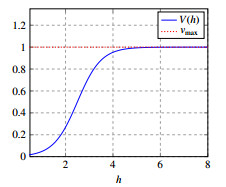









 DownLoad:
DownLoad:

